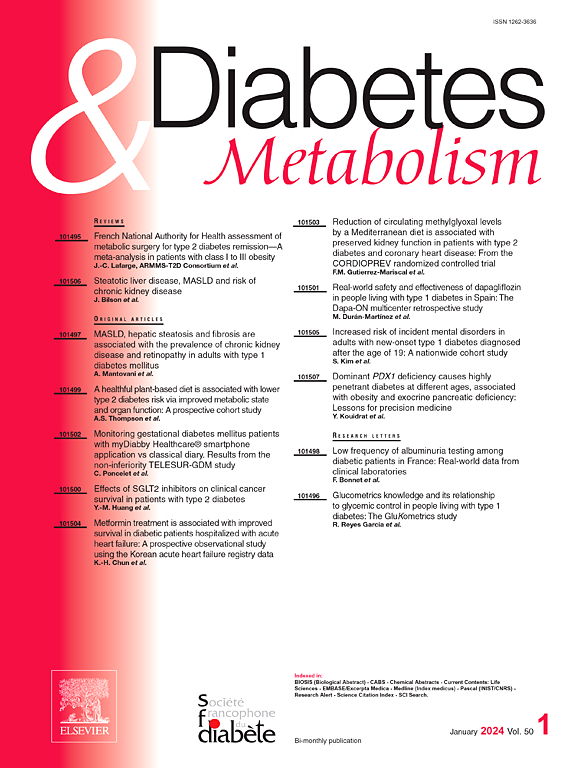Safety of sodium-glucose cotransporter 2 inhibitors in kidney transplant recipients with diabetes mellitus
IF 4.7
2区 医学
Q1 ENDOCRINOLOGY & METABOLISM
引用次数: 0
Abstract
Aim
Sodium-glucose cotransporter 2 inhibitors (SGLT2i) are important anti-hyperglycemic medications with reno-protective benefits for patients with diabetic kidney disease. Their utilization in kidney transplant recipients (KTRs) remains underexplored due to safety concerns, particularly regarding urinary tract infections. This study investigates the safety profile of SGLT2i therapy in KTRs.
Methods
We conducted a retrospective analysis of KTRs with diabetes mellitus, comparing those treated with SGLT2i to those on standard diabetes therapy, monitored over three years at a tertiary center. The primary outcome was a renal composite of dialysis, re-transplantation, acute kidney failure, or acute rejection. Secondary outcomes included urinary tract infections, diabetic ulcers, fractures, amputations, diabetic ketoacidosis, all-cause mortality, and glycemic control.
Results
Two hundred forty individuals using SGLT2i (median age 63, 20 % female) were matched with non-users. SGLT2i users had a lower incidence of the composite renal outcome (8.9 vs. 13.3 events per 100 patient-years), but after adjustment for independent predictors, the risk was similar (HR 0.99, 95 % CI 0.65–1.52, P = 0.970). Other outcomes showed comparable or lower risks in SGLT2i users. Glycemic control improved more significantly in SGLT2i users.
Conclusion
In KTRs with diabetes, SGLT2i therapy improved glycemic control without increased safety concerns compared to standard treatments. Both groups exhibited similar risks of significant kidney-related events and all-cause mortality. These findings provide crucial insights into the existing limited data concerning this vulnerable population, which faces elevated risks of renal complications and medication-related adverse effects. Ongoing randomized controlled trials will provide additional safety data for SGLT2i in KTRs.
钠-葡萄糖共转运蛋白2抑制剂在糖尿病肾移植受者中的安全性
目的:钠-葡萄糖共转运蛋白2抑制剂(SGLT2i)是糖尿病肾病患者重要的抗高血糖药物,具有肾保护作用。由于安全性问题,特别是尿路感染,它们在肾移植受者(KTRs)中的应用仍未得到充分探讨。本研究探讨了SGLT2i治疗KTRs的安全性。方法:我们对合并糖尿病的ktr患者进行了回顾性分析,将接受SGLT2i治疗的患者与接受标准糖尿病治疗的患者进行了比较,并在三级中心进行了三年的监测。主要结局是透析、再移植、急性肾衰竭或急性排斥反应的肾脏组合。次要结局包括尿路感染、糖尿病溃疡、骨折、截肢、糖尿病酮症酸中毒、全因死亡率和血糖控制。结果:240名使用SGLT2i的个体(中位年龄63岁,20%为女性)与非使用者相匹配。SGLT2i使用者的复合肾脏结局发生率较低(8.9 vs. 13.3事件/ 100患者年),但在调整独立预测因子后,风险相似(HR 0.99, 95% CI 0.65-1.52, P = 0.970)。其他结果显示SGLT2i使用者的风险相当或更低。SGLT2i使用者的血糖控制改善更为显著。结论:在合并糖尿病的ktr患者中,与标准治疗相比,SGLT2i治疗改善了血糖控制,但没有增加安全性问题。两组患者发生重大肾脏相关事件和全因死亡率的风险相似。这些发现为这一脆弱人群的现有有限数据提供了重要见解,这些人群面临肾脏并发症和药物相关不良反应的风险升高。正在进行的随机对照试验将提供SGLT2i治疗ktr的额外安全性数据。
本文章由计算机程序翻译,如有差异,请以英文原文为准。
求助全文
约1分钟内获得全文
求助全文
来源期刊

Diabetes & metabolism
医学-内分泌学与代谢
CiteScore
12.00
自引率
4.20%
发文量
86
审稿时长
13 days
期刊介绍:
A high quality scientific journal with an international readership
Official publication of the SFD, Diabetes & Metabolism, publishes high-quality papers by leading teams, forming a close link between hospital and research units. Diabetes & Metabolism is published in English language and is indexed in all major databases with its impact factor constantly progressing.
Diabetes & Metabolism contains original articles, short reports and comprehensive reviews.
 求助内容:
求助内容: 应助结果提醒方式:
应助结果提醒方式:


